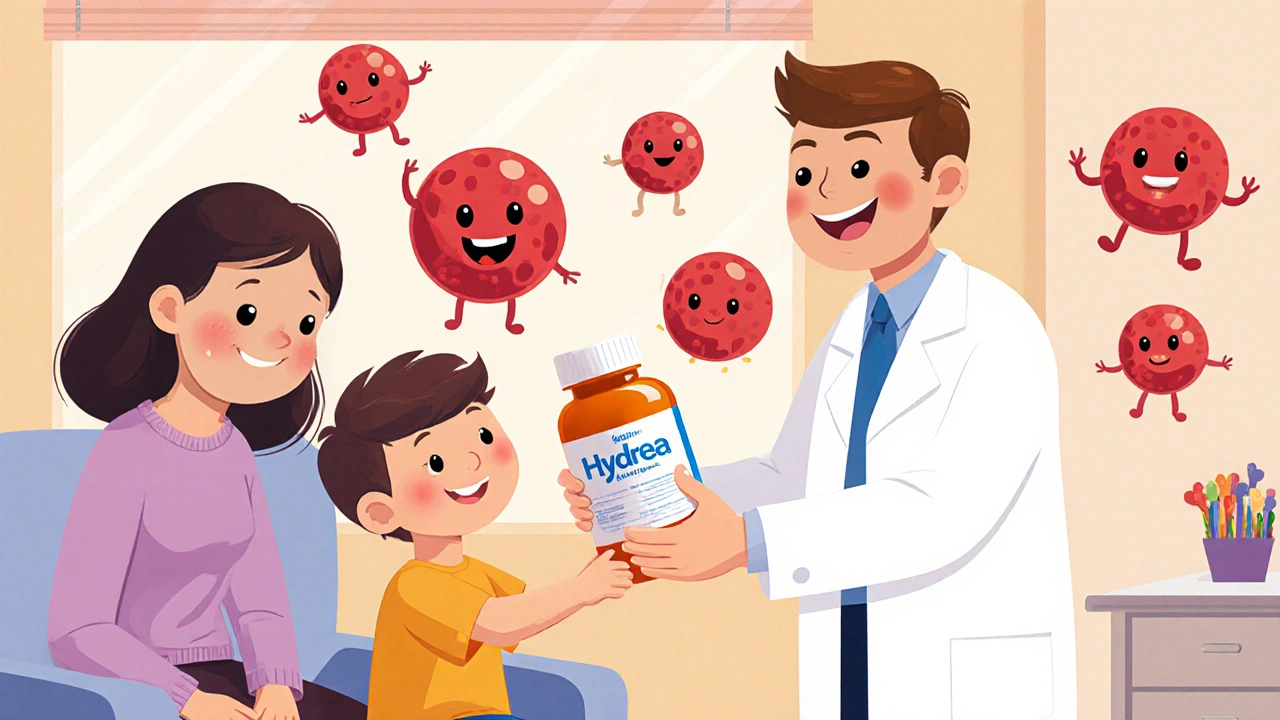Medication Selection Tool
Find Your Best Treatment Option
This tool helps you compare Hydrea and alternative medications based on your specific health situation. Select your criteria below and get personalized recommendations.
When doctors prescribe a disease‑modifying drug, they need to know not only how it works but also whether another option might fit a patient better. Hydroxyurea-marketed as Hydrea-has been a go‑to for conditions like sickle cell disease and certain blood cancers for decades. But newer agents and older chemotherapies are now in the mix, each with its own trade‑offs. This guide walks you through how Hydrea stacks up against the most common alternatives, so you can understand the pros, cons and when a switch makes sense.
What is Hydrea (Hydroxyurea)?
Hydrea (Hydroxyurea) is a synthetic ribonucleotide reductase inhibitor that reduces the production of deoxy‑ATP in red blood cells. By lowering the amount of sickled cells, it lessens vaso‑occlusive crises in sickle cell disease and helps control high blood counts in myeloproliferative neoplasms such as polycythemia vera. First approved by the FDA in the early 1970s, Hydrea is taken orally, usually once a day, and its dosage is adjusted based on blood counts and tolerance.
How Hydrea Works - The Mechanism in Plain Language
Ribonucleotide reductase is the enzyme that converts ribonucleotides into deoxyribonucleotides, the building blocks of DNA. Hydroxyurea blocks this step, slowing down DNA synthesis in rapidly dividing cells. In sickle cell disease, the drug also raises fetal hemoglobin (HbF) levels, which interferes with the polymerisation of sickle hemoglobin and reduces cell rigidity.
When Is Hydrea Prescribed?
The two biggest clinical buckets are:
- Sickle cell disease - to decrease painful crises, acute chest syndrome and the need for transfusions.
- Myeloproliferative neoplasms such as Polycythemia vera - to keep red blood cell mass under control and lower the risk of blood clots.
Guidelines from the Australian Therapeutic Goods Administration (TGA) and the American Society of Hematology list Hydrea as a first‑line, disease‑modifying option for both groups.
Key Benefits and Common Side Effects
What makes Hydrea attractive is its oral route, relatively low cost, and decades of safety data. Patients often see a 30‑50% drop in crisis frequency within the first three months of therapy.
On the flip side, the drug can suppress bone marrow, leading to neutropenia or thrombocytopenia. Gastro‑intestinal upset, skin hyperpigmentation and, rarely, leg ulcers are also reported. Regular blood monitoring every 2-4 weeks during dose titration is mandatory.
Alternative Medications Worth Knowing
While Hydrea remains a staple, several alternatives have entered the market. Below is a quick snapshot of each.
- Ruxolitinib - a JAK1/2 inhibitor approved for myelofibrosis and polycythemia vera. It works by curbing cytokine signalling rather than DNA synthesis.
- Pegylated Interferon alfa‑2a - an immune‑modulating agent that can raise HbF in sickle cell disease and drive molecular remission in certain leukemias.
- Busulfan - an alkylating chemotherapy used historically for chronic myelogenous leukemia (CML) and as a conditioning agent before stem‑cell transplant.
- Thalidomide - originally a sedative, now repurposed for multiple myeloma and some myeloproliferative disorders because of its anti‑angiogenic properties.
Side‑by‑Side Comparison
| Feature | Hydrea (Hydroxyurea) | Ruxolitinib | Pegylated Interferon alfa‑2a | Busulfan | Thalidomide |
|---|---|---|---|---|---|
| Route | Oral | Oral | Subcutaneous injection | Oral | Oral |
| Primary Indication | Sickle cell, Polycythemia vera | Myelofibrosis, Polycythemia vera | Sickle cell (off‑label), Myeloma | CML, Transplant conditioning | Multiple myeloma, Myeloproliferative neoplasms |
| Mechanism | Ribonucleotide reductase inhibition | JAK1/2 inhibition | Immune modulation, HbF induction | DNA cross‑linking | Anti‑angiogenesis, TNF‑α inhibition |
| Typical Cost (AUD per month) | ~$30‑$50 | $800‑$1,200 | $2,000‑$2,500 | $250‑$400 | $600‑$900 |
| Key Side Effects | Myelosuppression, ulcers, hyperpigmentation | Anemia, thrombocytopenia, infections | Flu‑like symptoms, depression, liver enzyme rise | Severe myelosuppression, pulmonary fibrosis | Peripheral neuropathy, constipation, teratogenicity |
| Monitoring Frequency | Every 2‑4 weeks (CBC) | Every 2 weeks (CBC, liver panel) | Monthly (CBC, thyroid, liver) | Weekly (CBC) during induction | Every 3 months (neurologic exam) |
How to Choose the Right Therapy
Picking a drug isn’t just about the headline efficacy; it’s about the whole patient picture. Use this decision checklist:
- Diagnosis certainty - Is the disease a classic sickle cell case or a complex myeloproliferative neoplasm?
- Age and reproductive plans - Thalidomide and some interferons are absolutely contraindicated in pregnancy.
- Cost considerations - Public health schemes in Australia cover Hydrea, but many newer agents require private funding.
- Side‑effect tolerance - Patients with a history of leg ulcers may struggle with Hydroxyurea, while those with chronic infections may avoid JAK inhibitors.
- Monitoring capacity - Clinics that can’t perform weekly labs might favour a drug with a longer dosing interval.
Discuss these points with a haematologist; often the best plan is a combination-starting with Hydrea to boost HbF, then adding a low‑dose JAK inhibitor if blood counts stay high.
Practical Tips for Patients on Hydrea
- Keep a medication diary - note any new bruises, fevers, or skin changes.
- Stay hydrated - it can help prevent the rare but painful leg ulcers.
- Schedule CBCs - set up automatic reminders so you never miss a test.
- Report pregnancy promptly - Hydroxyurea is teratogenic; a swift switch is vital.
- Ask about supplements - high‑dose folic acid is often recommended alongside Hydroxyurea to support healthy red cell production.
Future Directions - What’s on the Horizon?
Clinical trials in 2025 are testing gene‑editing approaches that could make lifelong drug therapy obsolete for sickle cell disease. Meanwhile, newer JAK inhibitors with fewer blood‑count impacts are in phase III. Until those data mature, Hydrea remains a dependable, evidence‑based option.
Frequently Asked Questions
Can I take Hydrea while pregnant?
No. Hydroxyurea is classified as pregnancy‑category D/teratogenic. Women of child‑bearing age must use effective contraception and switch to an alternative if pregnancy occurs.
How quickly does Hydroxyurea raise fetal hemoglobin?
Most patients see a 15‑20% rise in HbF within 8‑12 weeks of stable dosing; maximal effect may take up to 6 months.
Is Hydrea covered by Medicare in Australia?
Yes, the Pharmaceutical Benefits Scheme (PBS) lists Hydroxyurea for approved indications, making it largely subsidised for eligible patients.
What are the signs of bone‑marrow suppression?
Unexplained fatigue, frequent infections, easy bruising or prolonged nosebleeds. Immediate CBC testing is advised if any appear.
How does Ruxolitinib differ from Hydroxyurea?
Ruxolitinib targets the JAK‑STAT signalling pathway, reducing inflammatory cytokines and splenomegaly, whereas Hydroxyurea inhibits DNA synthesis and raises HbF. Their side‑effect profiles and costs are also distinct.
Whether you stay on Hydrea or switch to an alternative, the key is regular monitoring and open dialogue with your specialist. Armed with this comparison, you can make a more informed choice for your health journey.





3 Comments
eko lennon
Imagine stepping into a bustling clinic where the hum of monitors merges with the whispered anxieties of patients clutching prescription bottles; the air is thick with hope and the faint scent of antiseptic, and there I stand, a humble observer, watching the saga of Hydroxyurea unfold like an ancient drama on a modern stage. The drug, first whispered into existence in the early 1970s, has been the steadfast knight in shining armor for those battling sickle cell crises, its mechanism as elegant as a ballet dancer pirouetting around the ribonucleotide reductase enzyme. Each dose, taken once daily, is a small pact between the patient and science, a pact that promises fewer painful vaso‑occlusive episodes and a steadier hand on the wheel of life. Yet, as with any hero, Hydroxyurea bears the weight of paradoxical side effects that can creep in like sly thieves in the night, stealing blood cells and leaving bruises where none existed before. The marrow suppression, while a necessary sacrifice in the war against proliferating cells, can tip the balance toward neutropenia, inviting infections that sneak through the body's weakened defenses. Patients often report a strange skin hyperpigmentation, a reminder that even miracles leave their cosmetic scars, and the occasional leg ulcer appears as a grim reminder of the drug’s relentless grip. Monitoring becomes the rhythm of existence, with CBCs every two to four weeks acting as the metronome that keeps the treatment in time, a dance of dosage adjustments choreographed by haematologists. In the grand tapestry of therapy, the cost of Hydrea is modest, a few dollars that contrast starkly with the astronomical price tags of newer JAK inhibitors or pegylated interferons, making it accessible to those without deep pockets. The drug also boasts a unique ability to coax the fetal hemoglobin into the bloodstream, a silent guardian that softens the rigidity of sickled cells and reduces the frequency of crises by up to half within three months. But let us not ignore the alternatives that now line up like eager understudies: Ruxolitinib, with its JAK‑STAT choreography, offers relief from cytokine storms, while pegylated interferon steps onto the stage with immune‑modulating flair, albeit demanding subcutaneous injections. Busulfan, the old‑school alkylating agent, is reserved for the most aggressive battles, its DNA‑cross‑linking weaponry reserved for transplant conditioning, while thalidomide, a resurrected relic, brings anti‑angiogenic drama to the fore, though it carries its own teratogenic shadow. The decision matrix becomes a complex mosaic of diagnosis certainty, reproductive plans, financial realities, side‑effect tolerances, and the logistical capability of clinics to perform regular labs. In practice, many clinicians begin with Hydroxyurea, watching the hemoglobin F rise like a sunrise over the horizon, before considering a low‑dose JAK inhibitor if the blood counts refuse to settle. The story does not end here; future chapters hint at gene‑editing epics that may one day render chronic drug therapy a relic of the past, but until that science fiction becomes fact, Hydroxyurea remains the dependable, evidence‑based protagonist in the saga of hematologic care.
Sunita Basnet
Optimizing therapeutic index requires leveraging pharmacokinetic profiling and adhering to evidence‑based guidelines while integrating patient‑centred outcomes. Hydroxyurea’s oral bioavailability and cost‑effectiveness make it an anchor drug in sickle cell management and myeloproliferative neoplasms. Incorporating adjunctive folic acid supplementation can mitigate macrocytic anemia risk. Continuous CBC monitoring ensures dose titration aligns with hematologic targets. Collaborative care pathways enhance adherence and improve quality‑of‑life metrics.
Melody Barton
Listen up, you need to be aggressive about monitoring. Get those CBCs on schedule or you’ll end up with a crisis you could have avoided. Hydrea works, but if you let side effects slide you’re playing with fire. Push your doctor for the right dose and don’t settle for "just okay". Stay on top of it and you’ll keep those sickle cell attacks down.